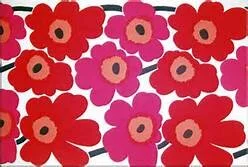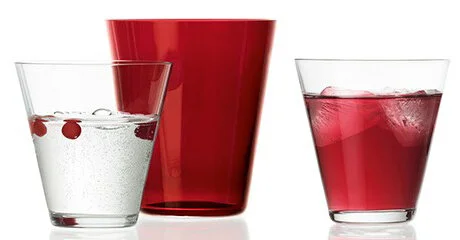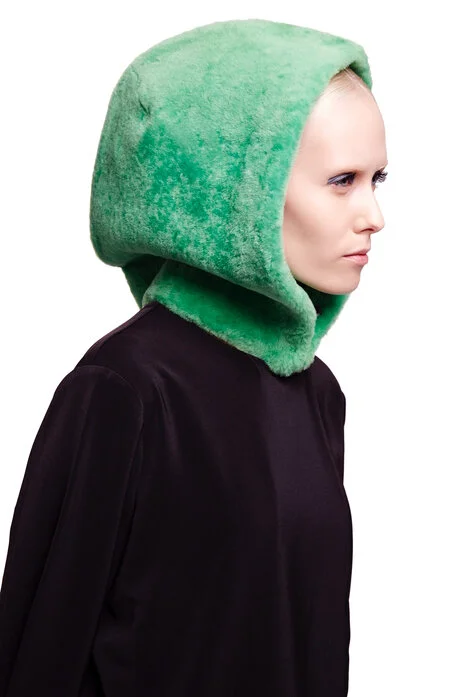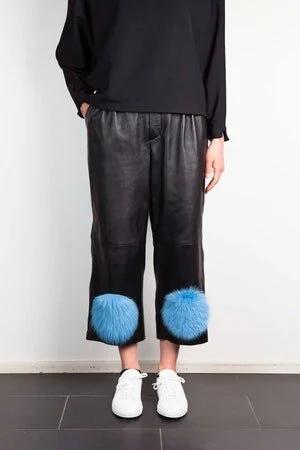Form & Fashion Finland & 100 Years of Independence 1917 - 2017
The Finnish fashion story starts with Armi Ratia, it is a portrait of the making of a modern nation.
Armi Ratia (1912-1979) was born in Karelia, Eastern Finland - now part of Russia. She studied in Helsinki and graduated as a textile designer in 1935. During her studies, the country was on its knees by war and hardship, with sombre grey as the tune of the day (Finland then had about 3,7 million - now 5.5million).
Once graduated, legend goes, Armi declared: “I am not a soldier, nor a general to be able to serve my country. I am only a textile designer but with this weapon I can produce colour to lift the spirit of my people.“
A bold statement, even bolder when put to action. To start with, Armi did not have the funds to purchase fabrics for her print ideas, so she approached to the Finnish army depot, asking if they had old bed-sheets to be discarded, she could use. They did, and so she acquired her first pile of cloth. It provided freedom to experiment with colourful print ideas, ultimately leading to the birth of Marimekko, Maries clothes, symbolising the everyday girl.
Armi started with the company Printex whose modern textiles were admired by people, but few knew what to do with the new patterns. So Armi and Viljo, her husband, organised a fashion show to demonstrate how the textiles could be used for clothes. It all started at Printex before it came Marimekko.
Marimekko’s first fashion collection was designed by Riitta Immonen, who made use of print patterns from different Finnish artists, including the starting print designer Maija Isola. The first fasion show was held at the Kalastajatorppa hotel in Helsinki in May 1951. The audience, much starved of anything invigorating and new, was enthralled by the colourful patterns and clean cuts. The clothes were sold almost right off the models’ backs. A few days after the show, Marimekko was officially registered as a company. The first Marimekko shop opened in Helsinki the following year.
Marimekko was founded on the 25th of May 1951. The logo was born in 1954 by using the typography of an Olivetti typewriter, all in lower case, m a r i m e k k o.
For a nation struggling with scarcity and greyness long after the second world war, Marimekko was like a gift, a source of colour and joy. It was welcomed with open arms by people who where embracing the hope these intense colours brought with them.
At the time, the significance of the strive, finding new living solutions was the ambition for creating a more socially equal society. The designer was not celebrated like God descended to earth, but the search for everyday design was a simple need to find a social and political structure, helping to eradicate poverty, bringing more social equality and an uplifting spirit filled with hope. Breaking with traditional bourgeois convention of how people where supposed to live, was part of the idea, finding new ways to conduct everyday life, was a mission. Like every ground breaking design, it is significant because it helps materialise new ideas beneficial to society.
Another important figure in the search for the 'new' was Vuokko Eskolinen Nurmesniemi - in short Vuokko, who did for Finnish women what Coco did for France. To summarise in short, the driving idea was, one should be able to move freely in one's clothes, making it an ambition at the time. Funny how such essential quest shaped the idea of 'the new'. Alongside her radical loose-fitting dress designs, Vuokko created one of the most enduring Marimekko classics, the unisex 'Jokapoika' (every-boy) shirt in the striped Piccolo pattern which has been in continuous production ever since. Now, this is how fashion wins through time, ever relevant, ever up-lifting. Vuokko later started her own design business under the simple name Vuokko, a business still alive and kicking today.
Maija Isola, a young designer who travelled to the continent of Africa in the mid 50's, a bit unusual for the time, brought back bold colour ideas in large scale patterns, something radical and unusual for a Nordic eye at the time. Maija created instant print classics such as the much copied Unikko flower, again in ongoing production through the years and continued through her life to produce 500 patterns for Marimekko, an extraordinary portfolio of work, not ever mastered by any other print designer.
Towards the end of the decade, the story of Marimekko began to spread across the seas, first it reached Sweden and soon after the United States, mainly through Jaqueline Kennedy. During the presidential election campaign, Mrs. Kennedy found the bright, simple Marimekko dresses in a small shop in Cape Cod where the Kennedy’s holidayed. She purchased the entire collection and won the hearts of the people. The fresh, new unconventional look gave her a more approachable appearance, helping to visually support Kennedy's democratic stance.
Armi was a trailblazer creating through Marimekko a way of life, an attitude, a phenomenon, embracing both the everyday and the extraordinary, always relevant for all ages and still so today.
The spirit of Marimekko is somehow reflected in the design at large in a country where the history of design is as present today as are new contributions. Images above illustrate Marimekko 1962 and 2017.
Everyday design for the home. A simple glass by Aino Aalto, entered under a pseudonym, won a glass design competition in 1932. We still use the glass around the world.
A Trienale winner was the Tank chair by Alvar Aalto in 1936 when also his Savoy vase saw the light of day.
Kaj Frank came 1952 with Teema, a whole new way of looking at tabletop and everyday dishes, a democratic mix and match was unheard of.
The Arne glass series by Göran Hongell was awarded the Gold Medal at the Milan Trienale in 1954, it is still to be found in design stores on all continents and has of course been endlessly copied.
All these ideas where born with the ambition to create simple, functional pieces for good everyday living, and so they do and continue serving us today.
Design in Finland is often sparse in its formation, more so than the design of the Nordic countries. This might be connected to the hardship Finland has gone through in a much more severe ways than the Nordic neighbours. Maybe it also has to do with the harsh, long winters. Nature forces humans to go within, look at the essentials needed for survival, keeping it simple. This might be something locked into the DNA, who knows……
Fact is, the simplicity of Finnish design is striking and strikingly beautiful because to get simplicity right, one needs to understand proportions and to get proportions right one needs to allow time to ponder and contemplate. If one allows time to move slowly, one finds beauty in its flow and so simplicity can be born in its full glory.
Finns are pragmatic, things need to function as functionality supports survival, but this does not mean it has to be boring, it simply stays relevant much loner through time.
Simplicity is also expressed through fashion and lifestyle products created today. There is a certain silence around simple form, something which is innate in the Nordic Finnish psyche, maybe because one is used to silence much more than on the continent and in Southern regions of the world.
The silence of snow is breathtaking and once experienced, never forgotten. Possibly because it is so soothing to the soul and likewise soothing are clean cut forms for the body and home as they allow people space to breath.
Take for example the Kartio glass, created by then Arabia’s artistic director Kaj Frank in 1958. It is the most simple glass ever, but somehow it lives on and on and on…… there is a genuine beauty, a harmony to it, with the idea of the glass, allowing it to be used for water, milk and wine alike, celebrating beauty for everyday living, stackable not taking much space and never boring because of the perfection in proportion..
Besides much celebrated simplicity one finds innovation and bucket loads of personality in design such as by master Tapio Wirkkala who has won more Gold Medals for Finland than any other designer ever. There is not a more comprehensive designer dead or alive who can compete with Tapio Wirkkala, who was a master in creating something out of very little such as for the Venice Biennale in 1956 when Finland participated by asking Wirkkala to build the national pavilion but had to excuse, they where not able to give him much more than a pile of wooden planks. His team built the pavilion in a few days, and the night before the opening someone had written ‘Viva Finlandia’ in the sawdust and with this cheering Finland won that years Gold Medal for best Pavilion. Built from a pile of planks winning first prize, something only a master can do! His wit, simplicity, craft and originality had no end, no matter what material or métier he worked.
One of his well known glasses is the so called Ultima Thule (ultimate vessel) glass which resembles the melting ice in spring, still in production and much cherished. Wirkkala designed everything from city planning over national monuments to furniture, glass, household goods, ornamental pieces, graphics for advertising and consumer goods. The book about Tapio Wirkkala Design is the biggest and fattest and he worked with one assistant only, not with an army of 100 as is popular today.
There are plenty more examples of both classic and contemporary design, showing a joyous parade of fantasy and explorer sprit such as the fabulous creations by ceramist Birger Kaipiainen, the anti-dode of simplicity, of which I am sure, our contemporary Klaus Haapaniemi loves to identify with.
Kastelhelmi, dew drops, droplets of water on glass by Oiva Toika in beautiful contemporary setting here in combination with Teema, never out of fashion always relevant..
Contemporary design
Uniqueness is something which defines Finland, strong expression by a contemplative nation. This might have to do with for generations of living in isolated areas surrounded by wild nature, triggering the imagination. A good example of vivid imagination is the current Klaus Haapaniemi with his never ending tales of creatures residing in an explosive wonderland. There is very much the strong story telling through fantastic shapes and colours, stemming from enchanting wild nature with the tales attached to it, and on the other hand the clarity of shape and material just like the clear spring water after the melting ice. Both aspects of the spectrum are needed to give variety of flavour and expression.
Ritva Puotila a contemporary, the artistic director, designer and co-founder of the Finnish design company Woodnotes. The company, founded in 1987 features products made from paper yarn, and is the first company in the world to use the material in a contemporary way. The products are unique and of high quality, produced in Finland. Quality of product always come with quality of manufacturing, looking to sustain people and the environment. Ritva is the queen of beautiful simplicity having reigned Finnish textile design for over 50 years. She never wavers from her mission to bring us beautiful simplicity of high quality.
Nikari - Nikari, founded 1967 in the village of Fiskars just proves that staying true to heritage, celebrating quality and craftsmanship has a future. It sustains a culture, people and the environment. The Nikari studio-workshop is located in the unique Fiskars village in southwest Finland, in the oldest machinery workshop of the country.
There are of course a wide string of re-known Finnish designers very much alive and kicking, not just pushing the boundaries on how we live our lives in Finland, but very much influencing the international arena. And with this I like to switch to Finnish Fashion today.
All elements forming society walk hand in hand, so also design and fashion. The development since the birth of Marimekko has been slow to bring variety into a small market dominated by a brand with a very strong handwriting. But the last 10 years have seen a shift and the shift contains to look outward, to collaborate with other nationalities, bringing new blood and a vast array of variety pared with high creativity and skill, making it highly enjoyable to watch the scene. Here a few examples, all very different, picked from a vast amount of offerings.
ONAR is a Helsinki-based design house established by Irene Kostas in 2014. ONAR means “dream” in ancient Greek, specialises in high quality clothes and accessories, leather bags and knitwear. ONAR is the fusion of unlikely matches. In the collections soft materials meet geometric forms, richness of texture meets minimalism, organic meets plastic and the stark Scandinavian lines meet the mystical. ONAR draws from the traditional craft of Finnish and Greek artisans.
Ensaemble was established in 2011, based in Helsinki. Next to a strong domestic presentation it has introduced works in Japan, Russia and Holland. The name Ensæmble represents the firm belief in collaboration both as a requirement of the complexity of our time as well as something hugely inspiring. Its most intimate form is the æ, a chiasma of the initials of the two designers Alisa Närvänen and Elina Peltonen. From this intimacy all works are extended to incorporate other life-worlds and invite a polyphony of interpretations through both artist collaborations as well as the everyday actions of wearing the clothing.
Minna Parikka
“My designs are like love letters from one shoe to another. Life is too short to take style too seriously.”
The Minna Parikka brand was born the day 15-year-old Minna decided shoes were her life’s true calling. Since then, the Helsinki-based designer’s fun and bold creations have hopped into our hearts and graced the feet of adventurous women around the world.
Minna’s love of footwear is based on the fact that shoes – unlike clothes – don’t have to be inhabited by a body in order to look attractive. When a woman steps into them – that’s when the magic happens. The right shoes can change how she looks, feels and is seen by others. As objects of desire for women and men, shoes aren’t just symbols of power – they’re the Holy Grail.
Saara Lepokorpi is a high end niche womenswear line, with an aim to revive an appreciation for craft and slowly produced garments. The perceived and practical value of ancient folk costumes, where the manufacturing process started with the textile weaving, was very different than that of most garments produced today.
Saara Lepokorpi has chosen to apply some ancient processes of careful production onto modern clothing. Recently she has specialised in a type of textile she calls un-wovens, which resembles an un-woven warp on a loom. The technique lends itself to whole panels of special textile material, as well as unique embroideries. Julia Mannisto - ‘Los Gatos Locazas’ - Mannisto Autumn/Winter 2017, unveiled at London Showrooms, marks the designer’s first outing after her acclaimed Central Saint Martins graduate collection. ‘Los Gatos Locazas’, freely translated as ‘The Happy Cats’, presents a modern vision of the marriage between a contemporary work-wear and traditional South American textile art. The collection borrows its garments from the construction site, ornamentation from the 15th century Incan empire and attitude from the Latin gangs of the West Coast. Are we seeing ski wear for skate boarders coming?
Laura Juslin graduated from the Aalto University School of Art, Design and Architecture in 2012, and has become recognized for clean, simple designs that harmonize both shape and cut. She uses carefully tuned colours often in the form of blocking, and structural and innovative materials. After presenting her awarded MA collection she was offered the position as Head Designer for a new Finnish label Siloa & Mook. Here, she answers our questions.
Satu Maaranen - Eyreka, I hope, Marimekko is blasting….. Satu must be Armi Ratia’s dream, would she still be alive - in the footsteps of Marimekko’s psyche, she is current and daring, with a strong sense of self and utterly refreshing in her bold statements.
Helsinki-based designer Satu Maaranen nabbed first prize at the prestigious Hyéres Fashion Festival 2013 by unanimous decision with her graduation collection from Aalto University School of Arts, Design and Architecture. To no surprise, she began her career at Marimekko, surprise, surprise…… where she still consults frequently, truly creating head turners.
FRENN is a Helsinki-based menswear line combining basic design with relaxed sophistication formed into Nordic simplicity. FRENN clothes may seem Nordic and simple, but they always have more to them than meets the eye. Like the Finns; quiet at first glance but straightforward, reliable and easy going, when you get to know them. FRENN menswear line is synonymous to exquisite, interesting materials and surprising design details meeting comfortable, but always sharp tailoring skills.
FRENN, honestly Helsinki.
Last but not least Samuji Design Studio offering a lifestyle idea in good Finnish design tradition, clear and uncompromising. As named by Vogue; Helsinki’s Coolest Fashion Designer.
Samu-Jussi Koski is a man of simple needs. Even though he is the designer behind the fashion line Samuji, and the former creative director of Marimekko, his day-to-day life orbits around the idea that less is more, and functionality is on par with great style. Late last year, he introduced a small collection of beautifully handmade, as he says ‘necessary’, interior decor pieces, which he named Koti, the Finnish word for home. They include locally crafted wood cutting boards, blown glass vases, and more….. In this collection, as in his chic utilitarian clothes, Koski’s love of timelessness and the organic is evident. And while his work may be where he expresses this aesthetic, it was definitely born in an entirely different place, far away from the worlds of fashion and design. “I spent my whole childhood in a small village in the middle of Finland,” Koski says. “I was always attached to nature.” And this is significant for the Finnish psyche at large, the closeness to nature, to live in symbiosis with it, is innate and ever occurring, which gives the creations a certain flavor of silence, and timeless beauty. Samuji, a prime example for timeless shape and quality, always relevant.
Fashion and form reflects the standards of living a country aspires to. Lets step forward with joy and care into the future. But however far we will travel in time, the Finnish fashion story is nothing without Armi.
* Fine *




































